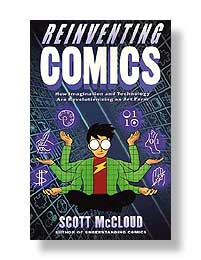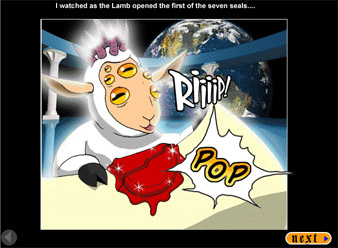Last week in Columbus, OH, I saw Scott McCloud give a fantastic presentation about creativity and storytelling using sequential art. I got two books signed, and since I was the last person on line, I started a little conversation about networked comics.
First off, it’s not every day that you get to meet one of your idols. He’s influenced the way that I think about storytelling and sequential art, which manages to have everyday repercussions in my work in interaction design and wireframing. Understanding Comics is right at the top of my practical reading guide with the Polar Bear book and Visual Displays of Quantitative Information.
Secondly, in Reinventing Comcis he covers a lot of territory with regard to the form that web comics can take and the method by which they can support themselves. But, as he notes in his presentation, while he was focused on the new openness of a boundless screen, webcomics recapitulated traditional forms and appeared like toadstools after a spring rain. As he said, “Tens of thousands—literally, tens of thousands of webcomics are out there today.” They are easy to find, but they’re guided by the goals of traditional comics, and made with many of the same choices in framing and pacing, even if their story lines are wildly varied.
In a previous post I said “The next step for online comics is to enhance their networked and collaborative aspect while preserving the essential nature of comics as sequential art.” I still think there’s something there, so I posed that questiont to Scott. He politely redirected, saying the form of a networked comic is completely unknown and that the discussion would last for many hours. Offhand, he knew of only a few experiments. He did say, “The process will be more interesting than the final product.” This is something that we say here with regards to Wikipedia, but even more so with collaborative fiction as in 1mil Penguins. So without further guidance, I ventured into the web myself, searching for examples of what I would call networked comics.
One nascent form of collaborative art has been the (relatively) popular practice of putting up one half of the equation—the art only, or the words only—and getting someone else to do the other half. If you said that sounds like regular comix, you’d be right. It’s normal practice in the sequential art world to have a writer and an artist collaborate on a story. But the novelty here is having multiple writers work with the same panels, with an artist who doesn’t know what she is drawing for. Words, infinitely malleable, are shaped to fit the images, sometimes with implausible but funny results. Here’s an example that Kristopher Straub and Scott Kurtz have started on Halfpixel.com. They call it “Web You.0 (beta),” with the tagline “Infinite possible punchlines!” You take an image, put new words in the balloons, and resubmit the comic. The result: user-generated comics. Not necessarily good comics, but that’s not quite the point.
But that’s about it. There isn’t much in the way of a discussion going on about networked comics. This is understandable: making images is hard. Making images that are tied to a text is harder. This is the art and science of comics, and it’s difficult to see how they can be pried apart to create room for growth without completely disrupting the narrative structures inherent to the medium. When I look for something that takes a form that is fundamentally reliant on the network, I come up short. Maybe it would look like a hyper-extended comic ‘jams’, with panels by different artists on an evolving storyline. Maybe the form of a networked comic is something like a wiki with drawing tools. Or better yet, an instruction to the crowd that results in something like Sheep Market or swarmsketch. It’s interesting to see what “art from the mob” looks like, and seems to have the greatest potential for group-directed authorship. Maybe it will be something like magnetic word art (those word magnets you find on your friend’s fridge and use to write non-sensical and slightly naughty phrases with), combined with some sort of automatic image search. Obviously there are a lot of possibilities if you are willing to cede a little of the artistic control that tends to be so tightly wound up in the traditional method of making comics. I hate to end my posts with “we need more experiments!” but given the current state of the discussion, that’s just what I have to do.
Category Archives: Scott_McCloud
digital comics
If you want to learn how to draw comics you can go to the art section of any bookstore and pick up books that will tell you how to draw the marvel way, how to draw manga, how to draw cutting edge comics, how to draw villains, women, horror, military, etc. But drawing characters is different than making comics. Will Eisner was the generator of the term ‘sequential art’ and the first popular theory of comics. Scott McCloud is his recent successor. Eisner created the vocabulary of sequential art in his long-running course at the School of Visual Arts in NYC. McCloud helped a generation of comic book readers grasp that vocabulary in Understanding Comics, by creating a graphic novel that employed comic art to explain comic theory. But both Eisner and McCloud wrote about a time when comic delivery was bound to newspapers and twenty-two page glossy, stapled pages.

Whither the network? McCloud treats the possibilities of the Internet in his second book, Reinventing Comics, but mostly as a distribution mechanism. We shouldn’t overlook the powerful affect the ‘net has had on individual producers who, in the past, would have created small runs of photocopied books to distribute locally. Now, of course, they can put their panels on the web and have a potential audience of millions. Some even make a jump from the web into print. Most web comics are sufficiently happy to ride the network to a wider audience without exploring the ‘net as vehicle to transform comics into uniquely non-print artifacts with motion, interactivity, sound.
But how might comics mutate on the web? At the recent ITP Spring show I saw a digital comics project from Tracy Ann White’s class. The class asks the question: “What happens when comics evolve from print to screen? How does presentation change to suit this shift?” Sounds like familiar territory. White, a teacher at ITP, has been a long time web comic artist (one of the first on the web, and certainly one of the first to incorporate comments and forums as part of the product.
When I did a little research on her, I found an amazing article on Webcomics Review discussing the history of web comics. (There’s also more from White there.) There has been some brilliant work done, making use of scrolling as part of the “infinite canvas,” but more importantly, work that could have no print analog due the incorporation of sound and motion. The discussion in Webcomics Review covers all of the transformative effects of online publishing that we talk about here at the Institute: interlinking, motion, sound, and more profoundly, the immediacy and participative aspects of the network. As an example, James Kochalka, well known for his Monkey vs. Robot comics and a simplistic cartoon style, publishes An American Elf. The four panel personal vignette is published daily-blogging with comics.

Other ground breaking work: Nowhere Girl by Justine Shaw, a long form graphic novel that proved that people will read lengthy comics online. Apocamon by Patrick Farley, is a mash up of Pokemon and The Book of Revelations. There is a well known series of bible stories in comic strip format – this raises that tradition to the level of heavenly farce (with anime). Apocamon judiciously uses sound and minor animation effects to create a rich reading experience, but relies on pages—a mode immediately familiar to comic book readers. The comics on Magic Inkwell (Cayetano Garza) use music and motion graphics in a more experimental way. And in Broken Saints we find an example where comic conventions (words in a comic style font, speech bubbles, and sequential images) fade into cinema.
As new technology enables stylistic enhancements to web comics, the boundaries between comics and other media will become more blurred. White says, “In terms of pushing interactive storytelling online games are at the forefront.” This is true, but online games dispense with important conventions that make comics comics. The next step for online comics is to enhance their networked and collaborative aspect while preserving the essential nature of comics as sequential art.
